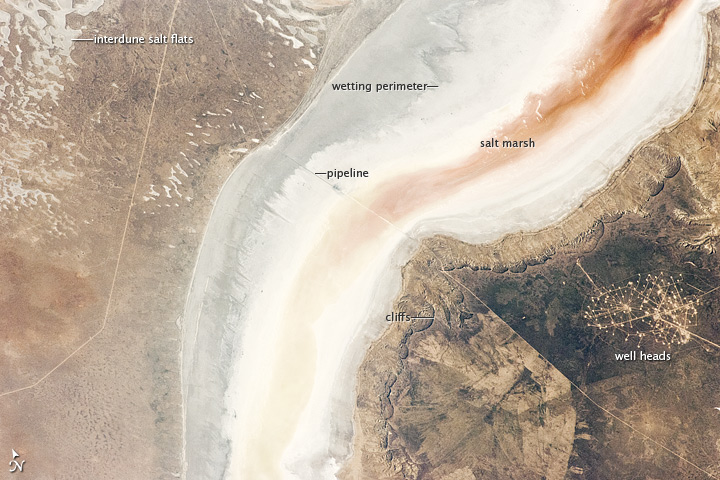
acquired May 11, 2012
download large image (465 KB, JPEG, 1440x960)
The Sor Kaydak is a salt marsh that
leads into the northeastern bulb of the Caspian Sea. This land
depression is occasionally inundated by water from the Caspian Sea, as
both the marsh and the Sea lie at the same elevation—29 meters below
global sea level. They are separated by a low bar of land that is just
1–2 meters high. The central 50 kilometers of the 180 kilometer-long
marsh depression is shown in this astronaut photograph from the
International Space Station.
Water in the marsh takes on different colors—from brown to pink to
light green, moving northeast to southwest—as a result of the interplay
of water depth and the resident organisms such as algae. Algae color
varies depending on water temperature and salinity.
Irregular gray areas (top left) are wet zones between low sand dunes.
These inter-dune flats are whitened with salt that comes from the
evaporation of Caspian Sea water. (The Sea is just beyond the top left
of the image.) The jagged line following the colored water is the limit
of the wetting zone (or perimeter), an irregular zone influenced by wind
and the depth of water in the marsh.
Small cliffs mark the eastern margin of the depression that contains
Sor Kaydak. Above the cliffs, a plateau—about 200 meters above the salt
marsh, 160 meters above global sea level—extends eastward for hundreds
of kilometers. Here the plateau is occupied by a dense pattern of well
heads, which appear as a geometric pattern of tan dots. By contrast, the
west margin (image left) rises less than 10 meters above the marsh.
The straight line visible at image center is a pipeline built to take
oil to a terminal on the Caspian shore 100 kilometers northwest of the
area shown here.
Astronaut photograph ISS031-E-30896
was acquired on May 11, 2012, with a Nikon D2Xs digital camera using a
180 mm lens, and is provided by the ISS Crew Earth Observations
experiment and Image Science & Analysis Laboratory, Johnson Space
Center. The image was taken by the Expedition 31 crew. It has been cropped and enhanced to improve contrast, and lens artifacts have been removed. The International Space Station Program supports the laboratory as part of the ISS National Lab
to help astronauts take pictures of Earth that will be of the greatest
value to scientists and the public, and to make those images freely
available on the Internet. Additional images taken by astronauts and
cosmonauts can be viewed at the NASA/JSC Gateway to Astronaut Photography of Earth. Caption by M. Justin Wilkinson, Jacobs/ESCG at NASA-JSC.
- Instrument:
- ISS - Digital Camera
Ricardo M Marcenaro - Facebook
Operative blogs of The Solitary Dog:
solitary dog sculptor:
http://byricardomarcenaro.blogspot.com
Solitary Dog Sculptor I:
http://byricardomarcenaroi.blogspot.com
Para:
comunicarse conmigo,
enviar materiales para publicar,
propuestas:
marcenaroescultor@gmail.com
For:
contact me,
submit materials for publication,
proposals:
marcenaroescultor@gmail.com
Diario La Nación
Argentina
Cuenta Comentarista en el Foro:
Capiscum
My blogs are an open house to all cultures, religions and countries. Be a follower if you like it, with this action you are building a new culture of tolerance, open mind and heart for peace, love and human respect.
Thanks :)
Mis blogs son una casa abierta a todas las culturas, religiones y países. Se un seguidor si quieres, con esta acción usted está construyendo una nueva cultura de la tolerancia, la mente y el corazón abiertos para la paz, el amor y el respeto humano.
Gracias :)

No hay comentarios:
Publicar un comentario